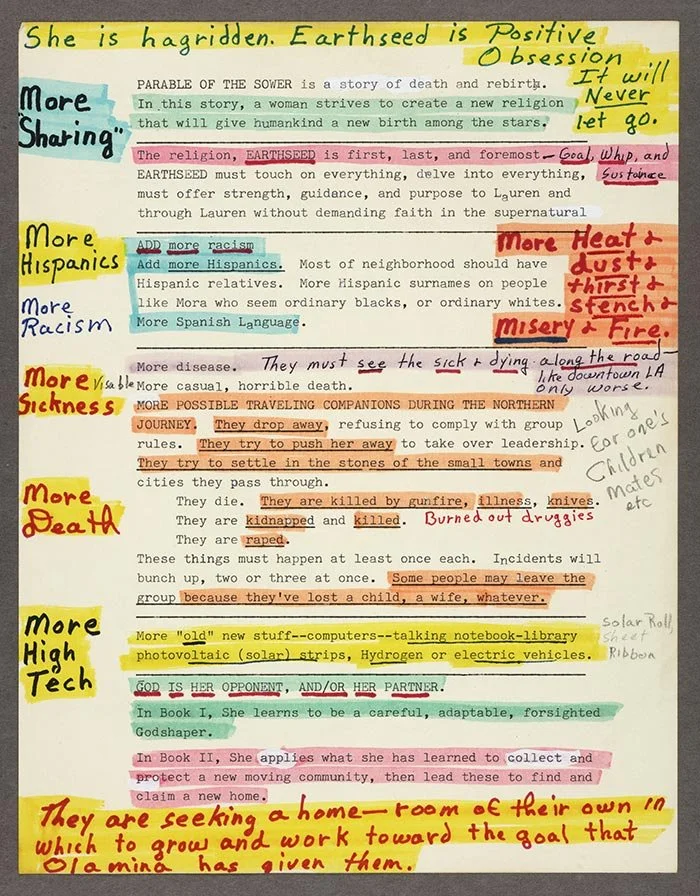Who Gets to Imagine Tomorrow? What Black Women Futurists Know That Silicon Valley Doesn't
When mainstream media talks about the future, you hear the same voices on repeat. Tech billionaires promising digital salvation. Startup founders selling disruption. White male futurists sketching chrome-plated tomorrows that somehow always look like now, but shinier.
Meanwhile, some of the most transformative visions of what's possible have been coming from Black women for decades. And their work doesn't just add diversity to the futurism roster. It changes what futurism is.
Rewriting the Rules of Time
Octavia Butler didn't write about the future as escape. She reconstructed how we think about time, power, and change itself. In her hands, tomorrow isn't a distant realm where technology saves us from ourselves. It's woven into the present, threaded through with past resistance and current struggle.
When Lauren Olamina in Parable of the Sower says "God is Change," she's not theologizing. She's articulating a completely different framework for transformation. One that starts from the body, from survival, from what people do when the systems that were supposed to protect them collapse.
Outline and notes for Parable of the Sower, ca. 1989. The Huntington Library, Art Collections, and Botanical Gardens. Copyright Estate of Octavia E. Butler.
This pattern shows up across Black women's futurist work. Nalo Hopkinson and Nnedi Okorafor don't drop Black characters into standard sci-fi plots and call it progress. They pull from African cosmologies, Caribbean epistemologies, Indigenous knowledge systems, and histories of collective resistance to build futures that don't just replicate the present with better gadgets.
Where mainstream futurism obsesses over technology, Black women futurists ask different questions: How do communities heal? How do we build kinship outside blood and law? What does freedom actually feel like in the body?
These questions are structural, not soft. They get at something Silicon Valley futurism consistently misses: technology without transformation just automates oppression.
adrienne maree brown's Emergent Strategy makes this explicit. Drawing from Butler and from natural systems, she maps how change actually happens. Not through top-down innovation or lone genius, but through small-scale interactions that compound, adapt, and spread. She's talking about mycelium and murmuration and how organizing works when you stop trying to control outcomes and start building capacity for response.
Collapsing the Distance Between Now and Next
What makes Black women's futurism so potent is how it refuses the gap between present and future. Ytasha Womack shows this in her writing on Afrofuturism: the work recognizes that Black communities have always been creating futures in real time. Through music, fashion, organizing, survival, refusal.
Janelle Monáe’s android alter ego Cindi Mayweather isn't a character from some far-off world. She's a lens for seeing current conditions more clearly. A way to name what's happening now and imagine what response might look like.
Speculative designer Lauren Williams makes artifacts from possible futures that expose the assumptions baked into our present. She treats them as tools, not thought experiments. Things you can touch. Things that make you feel the weight of what could be.
This is future-making as practice, not prophecy. And it comes from communities that never had the luxury of waiting for tomorrow. Survival required imagination. Resistance required speculation. You can't dismantle what you can't first envision otherwise.
Futures Are Collective or They're Not Futures
Here's where Black women futurists break most sharply from the Silicon Valley model: they don't dream about individual escape. While tech billionaires fantasize about uploading consciousness or colonizing Mars, writers like N.K. Jemisin build worlds where survival depends on new forms of connection, interdependence, and collective care.
The difference comes from epistemology, not from aesthetic preference. When your community survived through mutual aid, through networks of care that crossed bloodlines and geographies, you know the future isn't something that happens to isolated individuals. It's something we build together or not at all.
Building the Future in the Present
The work isn't just happening on the page. Organizations like the Octavia Butler Legacy Network and the Black Speculative Arts Movement are creating infrastructure for Black futures to develop, circulate, and take root. Artists, writers, and organizers are using speculative methods to help communities imagine what they want and start building it now.
These frameworks represent some of the most rigorous, sophisticated thinking we have for understanding how change works and what we need to do differently.
We're facing overlapping crises that require more than technological solutions. Climate collapse, racial violence, economic precarity. We need approaches that center healing, that build collective capacity, that imagine transformation instead of just survival with better tools.
Black women futurists have been developing exactly these frameworks. The question isn't just who gets to imagine the future. It's what kinds of futures we're capable of imagining, and whether we're ready to learn from traditions that have been doing this work all along.
When we expand who counts as a futurist and what futurism can do, we expand our capacity for real change. Black women's approaches remind us that the future isn't about breakthrough technologies or genius inventors. It's about the hard, daily work of imagining and building new ways of being together.
The question is whether the rest of us are ready to listen and put it into practice.
Want to explore different approaches to imagining and creating futures? Contact us to learn how we can help.
